Topics List
Nov. 2, 2015 Updated
Release of the JAXA Realtime Rainfall Watch
|
Earth Observation Research Center (EORC) of Japan Aerospace Exploration Agency (JAXA) has developed GSMaP realtime version (GSMaP_NOW) providing rainfall information of current hour, and released those information through a new webpage “JAXA Realtime Rainfall Watch”. |
 |
|---|
Sep. 2, 2014 Updated
GPM providing 3D precipitation data
|
Data acquired by the GPM Core Observatory, the JAXA/NASA joint development mission, has been provided to the public since Sept. 2. |
 |
|---|
Mar. 25, 2014 Updated
First Images Available from JAXA-NASA Global Rain and Snowfall Satellite
|
JAXA and the NASA have released the first images captured by their newest Earth-observing satellite, GPM Core Observatory, which launched into space Feb. 28 (JST). The images show precipitation falling inside a March 10 cyclone over the northwest Pacific Ocean, east of Japan. The data were collected by the GPM Core Observatory’s two instruments: JAXA’s Dual-frequency Precipitation Radar (DPR), which imaged a three-dimensional cross-section of the storm; and, NASA’s GPM Microwave Imager (GMI), which observed precipitation across a broad swath. |
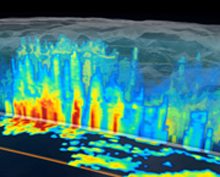 |
|---|
Feb. 28, 2014 Updated
Successful launch of H-IIA F23 with GPM core ovservatory aboard!
|
The launch of the H-IIA Launch Vehicle No. 23 with the core observatory for the Global Precipitation Measurement mission aboard was successfully performed at 3:37 a.m. on February 28 (Fri.) 2014 (JST). |
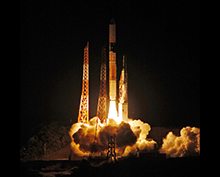 |
|---|
Jan. 17, 2014 Updated
GPM core observatory revealed to the media
|
On January 17 (Fri.), the GPM core observatory was shown to the media in the Spacecraft Test and Assembly Building 2 (STA2) at the Tanegashima Space Center (TNSC). |
 |
|---|
Dec. 26, 2013 Updated
Launch date set for GPM/DPR on H-IIA F23! Special site now available!
|
The launch date and time for the H-IIA Launch Vehicle No. 23 (H-IIA F23) withThe core observatory for the Global Precipitation Measurement mission onboard was decided to be at around 3:07 a.m. thru 5:07 a.m. (JST) on February 28 (Fri.,) 2014. |
 |
|---|
Nov. 29, 2013 Updated
GPM core observatory arrived at TNSC!
|
The core observatory for the Global Precipitation Measurement mission, which arrived at Kitakyushu Airport at 12:28 p.m. on Nov. 24 (Sun.) from the NASA Goddard Space Flight Center, was then transported via sea and land to the Spacecraft Test and Assembly Building 2 at the Tanegashima Space Center at 2:24 a.m. on the 27th (Wed.) |
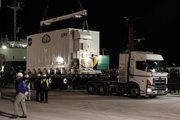 |
|---|
Nov. 25, 2013 Updated
GPM core observatory jointly developed by JAXA and NASA arrived in Japan!
|
The core observatory for the Global Precipitation Measurement (GPM) mission arrived at Kitakyushu Airport in Japan from the NASA Goddard Space Flight Center in the U.S.A. about 12:28 p.m. on Nov. 24 (Sun.) The GPM core observatory was jointly developed by JAXA and NASA. After arrival at the airport, the satellite was then transported to the Tanegashima Space Center by cargo ship for launch by the H-IIA Launch Vehicle. Its arrival here was originally scheduled for the 22nd, but it was delayed for two days due to bad weather in Alaska, where the cargo plane stopped for refueling. The GPM mission is a joint international project to observe global precipitation conditions quite frequently and accurately by combining the core observatory and a consternation of some eight satellites. The GPM mission will begin on a full scale when the core observatory, which came to Japan today, is launched, and it will become useful in many ways for our daily life including global-scale water resource control, damage mitigation for water-related disasters such as typhoons and floods, and weather forecasting accuracy improvement. The Dual-frequency Precipitation Radar (DPR) aboard the GPM core observatory developed by JAXA is one of the cutting-edge observation devices developed in Japan. It enables three-dimensional observations of rain with high sensitivity. |
 |
|---|
Apr. 9, 2013 Updated
Global Precipitation Measurement Live Event Ask JAXA and NASA!
|
The Global Precipitation Measurement (GPM) main satellite has been jointly developed by JAXA and NASA, and is scheduled to be launched in JFY 2013. [Event Information]
[How to ask questions]
[Other remarks]
|
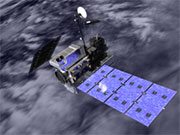 |
|---|
Jun. 6, 2012 Updated
The integration of the DPR was successfully completed
|
The integration of the Dual-frequency Precipitation Radar (DPR) onto the Global Precipitation Measurement (GPM) Core Observatory was successfully completed in May 2012. This DPR is expected to be much more versatile than the TRMM precipitation radar (also provided by JAXA) and these two are the only radar instruments currently dedicated to precipitation measurements from space. The data obtained by the DPR along with that of the NASA GPM Microwave Imager (GMI), also flown on the Core Spacecraft, will be used as a calibration standard for rainfall estimation from the GPM constellation satellites. The GPM mission will enable global measurement of precipitation every three hours. |
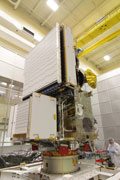 Two box- type instruments are DPR (C)NASA  Silver colored instrument on upper side is GMI made by NASA (C)NASA |
|---|
Apr. 2, 2012 Updated
DPR Delivered to NASA
|
Dual-frequency Precipitation Radar (DPR) that will be installed on the core satellite of the Global Precipitation Measurement (GPM) mission was delivered to NASA’s Goddard Space Flight Center (GSFC), Greenbelt, MD on March 30. |
 |
|---|
Feb. 10, 2012 Updated
Dual-frequency precipitation radar (DPR) released to the media
|
On Feb. 9, JAXA unveiled the dual frequency precipitation radar (DPR), which will be onboard the main satellite for the Global Precipitation Measurement (GPM) project. |
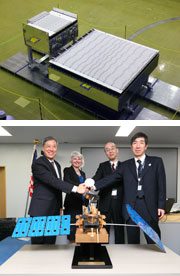 |
|---|
Sep. 7, 2011 Updated
Logo for GPM dual-frequency precipitation radar selected
|
JAXA has decided on the logo mark for the dual-frequency precipitation radar (DPR) aboard the main satellite of the Global Precipitation Measurement (GPM) project. |
 |
|---|
Jun. 30, 2011 Updated
Integration test of the dual-frequency precipitation radar with KuPR and KaPR
|
The dual-frequency precipitation radar (DPR) for the Global Precipitation Measurement (GPM) project has been under development. The DPR will be loaded onto the main satellite of the GPM project, which aims to broaden observation coverage to a higher latitude compared to the Tropical Rainfall Measuring Mission. The DPR is equipped with two different frequency radars of Ku-band and Ka-band (KuPR and KaPR,) and it can observe light rain, pouring rain and snow simultaneously. |
 |
|---|
Aug. 3, 2009 Updated
Memorandum of Understanding with NASA for cooperation in GPM Project
|
JAXA and NASA signed a Memorandum of Understanding (MOU) on development and operation activities for the Global Precipitation Measurement (GPM) project to measure precipitation (such as rain and snow) using a multiple number of satellites on July 31, 2009 (Japan Standard Time). With this MOU, the two organizations will further deepen the cooperative relationship and exercise comprehensive leadership utilizing the research and development ability and personnel of the two parties. |
 |
|---|
Mar. 18, 2009 Updated
Vibration test of the DPR thermal/structural models
|
Development of the Dual-frequency Precipitation Radar (DPR), which will be installed in the Global Precipitation Measurement (GPM) satellite, has been underway. The DPR is composed of two radars with two different frequencies (KuPR and KaPR) to precisely measure light rain, heavy rain and snow at the same time. We are carrying out environment tests using the DPR thermal and structural models at the Tsukuba Space Center. The photo shows the vibration test on the Ku-band radar model. |
 |
|---|
Oct. 17, 2008 Updated
Testing the KuPR Radar Engineering Model
|
Development of the Dual-frequency Precipitation Radar (DPR) that will be installed in the Global Precipitation Measurement (GPM) satellite has been underway. The DPR is composed of two antennas with two different frequencies (KuPR and KaPR) to precisely measure light rain, heavy rain and snow at the same time. We are carrying out the antenna pattern measurement and radar operation verification for the Ku band radar by using its engineering model at the Radio Test Building at the TKSC. |
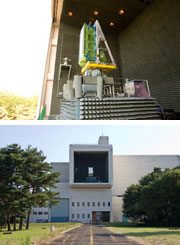 |
|---|
Apr. 30, 2002 Updated
|
The Global Precipitation Measurement (GPM) concept was based on TRMM`s achievements, and this concept is currently being studied. The GPM satellites consist of a TRMM-type primary satellite that carries a radar and a microwave radiometer and a fleet of constellation satellites that carry microwave radiometers. The primary satellite plans to go to higher latitudes than TRMM to extend the coverage. The constellation satellites will measure precipitation frequently and globally. GPM is currently planned to start operating in 2007-2008 timeframe. The primary satellite is planned to carry a Dual-frequency Precipitation Radar (DPR) and a microwave radiometer. The combination of these two instruments will improve the accuracy of rainfall measurement and also realize snowfall observation, especially at higher latitudes. The 2nd GPM International Planning Workshop will be held from 20th (Mon.) through 22nd (Wed.) May 2002 at the Shinagawa Prince Hotel in Tokyo. The National Space Development Agency of Japan (NASDA), the Communications Research Laboratory (CRL) and the U.S. National Aeronautics and Space Administration (NASA) will co-host this workshop. Please see more details here . |
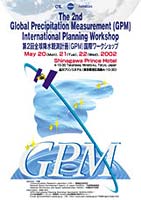 |
|---|
This entry passed through the Full-Text RSS service – if this is your content and you’re reading it on someone else’s site, please read the FAQ at fivefilters.org/content-only/faq.php#publishers.
Comments are closed.